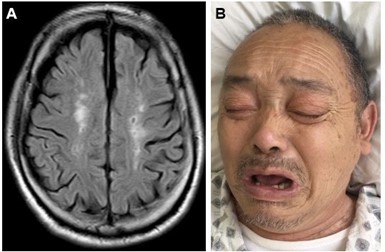Annals of Medical & Surgical Case Reports
(ISSN: 2652-4414)
Image Article
Pathological Crying Following Acute Lacunar Infarction
Zhao-Wen Zhang1,2, Wei Liu*1,2
1Institute of Digestive Disease, China Three Gorges University, Yichang, China
2Department of Gastroenterology, Yichang Central People’s Hospital, Yichang, China
*Corresponding Author: Wei Liu, Institute of Digestive Disease, China Three Gorges University, 8 Daxue Road, Yichang 443000, China
Citation: Zhang ZW, Liu W (2020) Pathological Crying Following Acute Lacunar Infarction. Ann Med & Surg Case Rep: AM- SCR-100090
Received date: 12 December 2020; Accepted date: 23 December 2020; Published date: 29 December 2020
A 62-year-old man presented to the emergency department with a 2-hour history of slurred speech and mental status. His past medical history was of type 2 diabetes and hypertension of 3 years’ duration. The pulse was 80 beats per minute, and the blood pressure 147/93 mm Hg. Computed tomography of the head revealed no signs ofcerebral hemorrhage. 3 hours after admission, he suffered progressive muscular weakness in the right limbs. A physical examination revealed positive reflex of Babinski sign. Given the recent changes in the patient’s mental status and pathological reflex, magnetic resonance imaging (MRI) of the head was assessed and confirmed acute bilateral lacunar infarction (Figure 1A). 2 days after admission, he suffered pathological crying (Figure 1B). The diagnosis of pathological crying following acute lacunar infarction depended on the typically characteristic clinical and MRI manifestations. Patients with some neurologic diseases exhibit exaggerated episodes of crying without an apparent motivating stimulus [1, 2]. During these episodes, patients have difficulty in controlling their emotional expression [3, 4]. After a well-informed discussion of options for interventions with the patient’s family, the decision was made to pursue anti-platelet-aggregation agents and vasodilator therapy. He was discharged home with synchronous resolution of slurred speech and muscular weakness symptoms, but had been suffering pathological cryingfor 5 years with outpatient follow-up.
Acknowledgements
Funding: This work was supported by National Natural Science Foundation of China (31600134).
Conflicts of Interest: The authors have no conflicts of interest to declare.
Ethical Statement: The authors are accountable for all aspects of the work in ensuring that questions related to the accuracy or integrity of any part of the work are appropriately investigated and resolved. Written informed consent was obtained from the patient for publication of this “Images in Clinical Medicine”

Figure 1: Pathological crying following acute lacunar infarction. (A) Magnetic resonance imaging of acute lacunar infarction; (B) image of pathological crying
Citation: Zhang ZW, Liu W (2020) Pathological Crying Following Acute Lacunar Infarction. Ann Med & Surg Case Rep: AM- SCR-100090